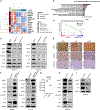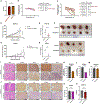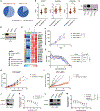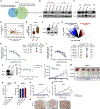Targeting DNA methylation and B7-H3 in RB1-deficient and neuroendocrine prostate cancer
- PMID: 37967200
- PMCID: PMC10954288
- DOI: 10.1126/scitranslmed.adf6732
Targeting DNA methylation and B7-H3 in RB1-deficient and neuroendocrine prostate cancer
Abstract
Aberrant DNA methylation has been implicated as a key driver of prostate cancer lineage plasticity and histologic transformation to neuroendocrine prostate cancer (NEPC). DNA methyltransferases (DNMTs) are highly expressed, and global DNA methylation is dysregulated in NEPC. We identified that deletion of DNMT genes decreases expression of neuroendocrine lineage markers and substantially reduced NEPC tumor development and metastasis in vivo. Decitabine, a pan-DNMT inhibitor, attenuated tumor growth in NEPC patient-derived xenograft models, as well as retinoblastoma gene (RB1)-deficient castration-resistant prostate adenocarcinoma (CRPC) models compared with RB1-proficient CRPC. We further found that DNMT inhibition increased expression of B7 homolog 3 (B7-H3), an emerging druggable target, via demethylation of B7-H3. We tested DS-7300a (i-DXd), an antibody-drug conjugate targeting B7-H3, alone and in combination with decitabine in models of advanced prostate cancer. There was potent single-agent antitumor activity of DS-7300a in both CRPC and NEPC bearing high expression of B7-H3. In B7-H3-low models, combination therapy of decitabine plus DS-7300a resulted in enhanced response. DNMT inhibition may therefore be a promising therapeutic target for NEPC and RB1-deficient CRPC and may sensitize B7-H3-low prostate cancer to DS-7300a through increasing target expression. NEPC and RB1-deficient CRPC represent prostate cancer subgroups with poor prognosis, and the development of biomarker-driven therapeutic strategies for these populations may ultimately help improve patient outcomes.
Conflict of interest statement
Figures







References
-
- Siegel RL, Miller KD, Fuchs HE, Jemal A, Cancer statistics, 2022. CA Cancer J. Clin. 72, 7–33 (2022). - PubMed
-
- Swami U, Aggarwal H, Zhou M, Jiang S, Kim J, Li W, Laliberté F, Emond B, Agarwal N, Treatment patterns, clinical outcomes, health care resource utilization and costs in older patients with metastatic castration-resistant prostate cancer in the United States: An analysis of SEER-Medicare data. Clin. Genitourin. Cancer 21, 517–529 (2023). - PubMed
-
- Beer TM, Armstrong AJ, Rathkopf DE, Loriot Y, Sternberg CN, Higano CS, Iversen P, Bhattacharya S, Carles J, Chowdhury S, Davis ID, de Bono JS, Evans CP, Fizazi K, Joshua AM, Kim C-S, Kimura G, Mainwaring P, Mansbach H, Miller K, Noonberg SB, Perabo F, Phung D, Saad F, Scher HI, Taplin M-E, Venner PM, Tombal B; PREVAIL Investigators, Enzalutamide in metastatic prostate cancer before chemotherapy. N. Engl. J. Med. 371, 424–433 (2014). - PMC - PubMed
-
- de Bono JS, Logothetis CJ, Molina A, Fizazi K, North S, Chu L, Chi KN, Jones RJ, Goodman OB Jr., Saad F, Staffurth JN, Mainwaring P, Harland S, Flaig TW, Hutson TE, Cheng T, Patterson H, Hainsworth JD, Ryan CJ, Sternberg CN, Ellard SL, Fléchon A, Saleh M, Scholz M, Efstathiou E, Zivi A, Bianchini D, Loriot Y, Chieffo N, Kheoh T, Haqq CM, Scher HI; COU-AA-301 Investigators, Abiraterone and increased survival in metastatic prostate cancer. N. Engl. J. Med. 364, 1995–2005 (2011). - PMC - PubMed
Publication types
MeSH terms
Substances
Grants and funding
LinkOut - more resources
Full Text Sources
Medical
Molecular Biology Databases
Research Materials
Miscellaneous

